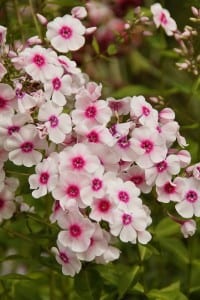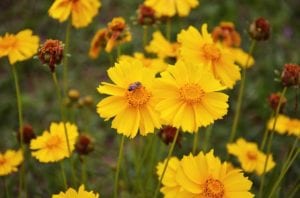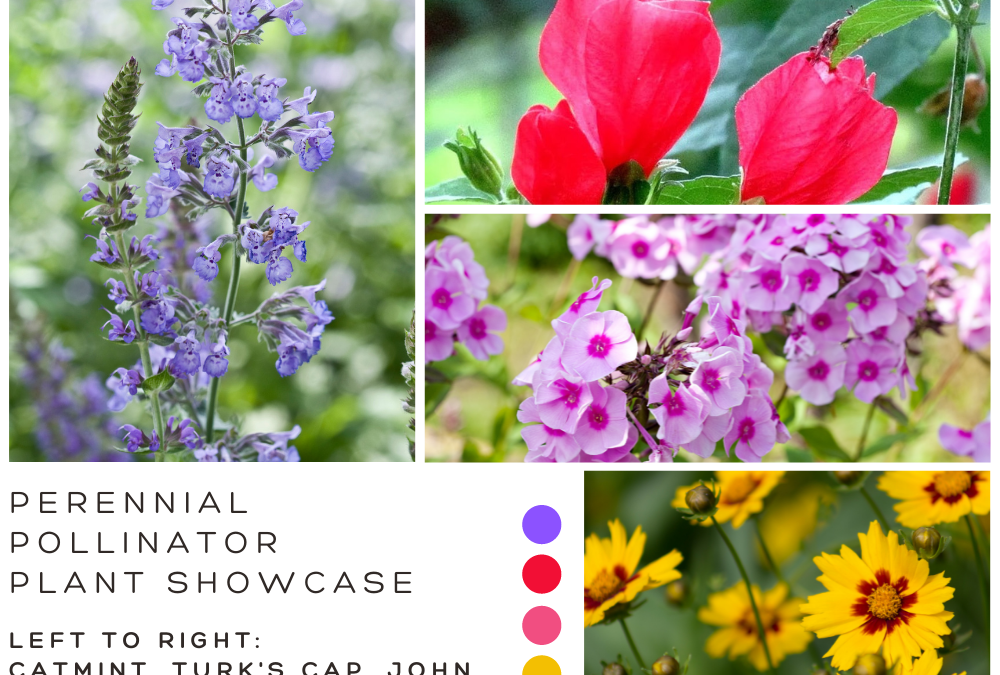Today I am offering a “quick look” at some perennial pollinator plant options that we have been bringing into Rainbow Gardens lately. If you desire pollinators to visit your garden in abundance, you might want to consider adding one or all of these to your landscape. Take a look at the growing requirements for these perennials to see if you have the perfect place for them. See more perennial pollinator options here.
4 Perennial Pollinator Plant Options
1. John Fanick Phlox: A Texas Superstar® plant, John Fanick phlox is sought after every year. Profuse, huge clusters of light-pink blooms with dark pink centers, this perennial delights pollinators all summer long.
- Light Requirement: Full Sun (but they appreciate some afternoon shade in our area)
- Water Requirement: Drought and Heat Tolerant
- Soil Requirement: Well Draining
- Growth Habit: 3 feet tall x 2 feet wide
- Fragrant: Yes

2. Turk’s Cap: This perennial pollinator plant produces some of the most adorable flowers ever! they resemble a little fez, hence the name Turk’s Cap. These bright red (or pink) blooms pop out all over the true-green foliage from early summer to fall. They are a hummingbird magnet!
- Light Requirement: Part Sun or Shade (can even adapt to full sun, but better in part shade)
- Water Requirement: Moist or Dry (adaptable to both)
- Soil Requirement: Neutral, but well-draining
- Growth Habit: 3-6 feet tall x wide
- Fragrant: No
- Edible Flowers and Fruits, Deer Resistant

3. Coreopsis: These sunshine-yellow perennial pollinator plants are perhaps one of the most cheerful plant options out there. You’ll enjoy their happy blooms late spring through summer and sometimes in to fall. Their ease of care makes them even more desirable. Many different varieties of coreopsis are available, but in general, most have the following characteristics
- Light Requirement: Full Sun
- Water Requirement: Dry to Medium
- Soil Requirement: Thrives in poor, rocky soil with good drainage
- Growth Habit: 1.5 feet – 2 feet tall x wide
- Fragrant: No
- Deer Resistant, disease resistant, self seeding (deadheading spent blooms helps prevents self seeding and also encourages more blooms)

4. Catmint: This perennial pollinator plant is often confused with catnip. But while catmint is not very attractive to felines, it sure is attractive to pollinators! This aromatic herb produces spikes of lavender-blue flowers on top of grayish-green foliage that bloom late spring to early fall.
- Light Requirement: Sun to Partial Shade
- Water Requirement: Heat and drought Tolerant (Water regularly until established)
- Soil Requirement: Average, Well-Draining
- Growth Habit: Size can vary. Average 1.5-2 feet tall x 3-4 feet wide
- Fragrant: Yes
- Herb, Great in vegetable gardens as a pest deterrent, in the same family as lavender and rosemary, easy to care for.
- Keep with it, we have found it does even better the following year after planting it.

We love to highlight pollinator plants and think that perennial options are terrific as they come back to offer nectar year after year. Hope you’ll take a closer look at some of these and treat the pollinators and yourself to some great plants!
~The Happy Gardener, Lisa Mulroy


Hello Laura , I’m interested in the
j Fannick phlox .
I’ve been by the butterfly garden area twice & not found any.
One of the young guys told me I should check with you.
Hi Regina, This is Lisa, not Laura, but I can put you in contact with her through The Butterfly Landing page on Facebook. This past week we got in a lot of 1 gallon John Fanicks phlox so they should be stocked in the butterfly garden if you go by this weekend. If you don’t see them in that area, just flag down an employee to show you where they are. We have them in several locations at the nursery.
I’m a beekeeper looking for pollinators plan. I live outside Boerne so deer, rabbits will be an issue and suggestions
Hi Sandy,
Without knowing what type of sun exposure you have or soil type, etc… it would be difficult to advise on which plants would be good choices for you. We have a Pollinator Gardening 101 class on May 11th at our Bandera location that will be a wealth of pollinator information that you may want to sign up for. Otherwise, I am attaching a list of some of our favorite pollinator plants and our deer resistant list so you can cross reference plants you may be interested in.
Hello, I live on the 3rd floor in an apartment with a balcony. Can I plant these pollinator plants in containers hanging from my balcony fence? There is a lot of butterflies right now on the street level right under my apartment.
Hi Minerva,
I think the only one you might not want to plant in container is Turk’s cap, just because it likes to spread by traveling underground and get a little big. But you can plant perennials like lantanas, salvias, coreopsis, and more, as well as cool weather annuals like pansies, Johnny Jump Ups, snapdragons and more and you’ll have butterflies very excited to visit your balcony. I don’t know what kind of light you have there, so you’ll need to pick plants based on that. There are a ton of pollinator plants you can pot up. Come visit!